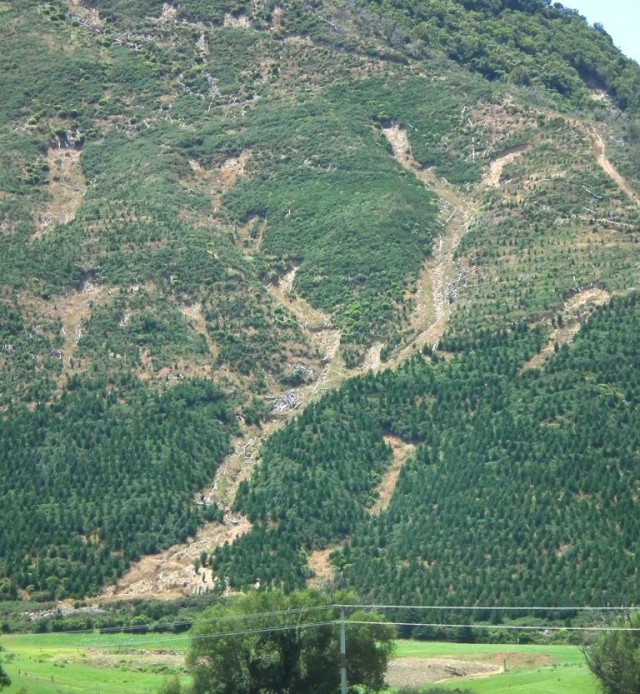15 January 2012
Landslides and logging – an pictorial example from New Zealand
Posted by Dave Petley
As I was driving across from Nelson to Picton in New Zealand yesterday (in quite glorious weather), I came across this recently logged and replanted slope:
This is a nice example of the way that logging causes a short-term landslide problem. It should be clear from the picture above that the logged areas have suffered significant shallow landsliding, whilst the upper, still forested, slopes are much more stable. In a couple of places the landslides are quite interesting. The largest appears to be this complex on the lower right side:
This complex is actually several (I think about ten) very small slips that have each entrained material and then entered the drainage line. As a result the amount of debris at the toe of the slope is quite large. This illustrates two major problems with deforestation. First, when trees are present these small slips are much less likely (the strength accorded by roots is enough to prevent themfrom starting, for example). Second, trees prevent small slips from entraining debris from the slopes below, and from entering the drainage line.
It is also interesting to note that several of the other small landslides in this picture started just above the tracks, where the slopes have been cut to create the road bench. This is very common, and indeed was a key factor in the devastating Sarno landslides in Italy in 1998, which killed about 150 people.
Another interesting landslide is on the left side of the slope:
This slip appears to have initiated at the bottom of a natural topographic hollow. Imagine what happens in heavy rainfall with the original trees missing – the water flowing across the surface and through the soil will be focused into this area, allowing a small landslide to start. Again a comparatively small slide has then turned into quite a large event as it has entrained material downslope. This also illustrates the difficulty of restabilising a slope that has started to slip. Planting trees is often touted as the simple solution, but stabilising the soil long enough for trees to take root and start to strengthen the soil can be a real problem. Nature gets around this problem through a vegetation succession (the slip above has started to be colonised by small plants and shrubs), but this can be a slow process. Humans often want or need to act much more quickly.





 Dave Petley is the Vice-Chancellor of the University of Hull in the United Kingdom. His blog provides commentary and analysis of landslide events occurring worldwide, including the landslides themselves, latest research, and conferences and meetings.
Dave Petley is the Vice-Chancellor of the University of Hull in the United Kingdom. His blog provides commentary and analysis of landslide events occurring worldwide, including the landslides themselves, latest research, and conferences and meetings.